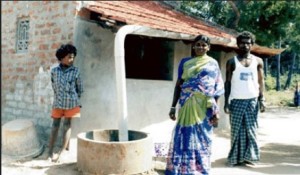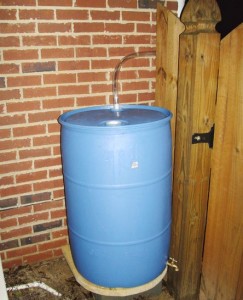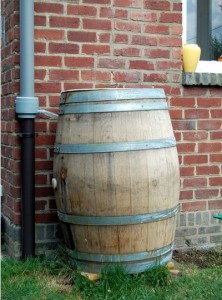Rainwater Harvesting Basics and Deviations for Various Situations and Needs
By Ava.
Many may take the water that flows into our taps for granted, but that mindset might go any time soon. Why? Right now, humanity is facing a global water crisis. The water that many of us are using right now is dwindling at a steady rate. In addition, over 700 million people right now do not have access to clean and safe water that they rightfully deserve, and this number can double or even triple without warning.
This led many to consider getting water from other sources besides the water offered by the utility companies whose services they currently subscribe to, and so far, they have found that rain is the best source of water. Rain comes naturally and will never “run out.” In addition, because it comes from nature, it is usually clean, although you have to watch out for reports of acid rain in your area, especially if you live in a heavily-polluted area. In such instances, not only should you stop collecting rainwater, you should also take down your harvesting system lest the acidic water damage it.
To make a basic rainwater harvesting system, you only need to follow these steps below:
The first step is getting all of the things that you need: a barrel, a hose with one-inch inner diameter, utility knife or ¾-inch drill bit, a drill bit measuring an inch, nylon ¾ – 1 inch MIP to barb adapter, a drill, a hose bib (a garden tap) with ¾-inch measurement, and a PVC rainwater collector. Take note that you can make your own diverter. Just make suer that it can handle overflow once the barrel fills up.
Make a hole for the water to get into your barrel. You can accomplish this using your drill, drill bit, and the adapter (MIP to Barb). Take a look at the plug (small circular ‘cover’) on the barrel. Do you notice how the circular-shaped depression at the middle is threaded? This is so you can connect the barrel to a source of water without the need to cut open a huge part of it. To make this part of the barrel useful for your rainwater harvesting system, just drill the bottom of the hole suing a ¾ drill bit. You can also cut it away using a utility knife, and if you have decided to do this instead of using the drill, make sure to exercise caution so you avoid damaging the threads.
Next, tightly screw the plug into the barrel and then the adapter into the plug. Not screwing both components tightly causes more impurities to get in the barrel.
This group of steps is for the installation of the tap or hose bib.
- Mark where the garden tap should be placed. You want to maximise the use of the rainwater you harvested and stored, so place the tap at the bottom part of the barrel.
- Drill a hole measuring an inch to mount your garden tap.
- Screw the garden tap into the barrel.
At this point, the rain barrel is ready for used. However, the rain barrel is not the only thing that you need to make a fully functional rainwater harvesting system.
Then mount the barrel on a platform made using tough wood and nails. Make sure to place the platform on a flat surface near the downspout so the barrel does not fall. Also, make sure that the top of the platform is completely level. Any protrusions will damage the barrel in the long run.
Hook the PVC rainwater diverter to the downspout. (Note: Basing on the above steps, the diverter you should purchase is one that makes rainwater to come out through a small tube.) Do this by cutting part of the downspout crosswise and at the right height, and then screwing the rain diverter to it.
After doing the above, attach and seal the hose to the diverter and the MIP to Barb adapter.
Enjoy your rainwater harvesting system!
Some deviations / options for your rainwater harvesting system
If you have access to wine barrels or just prefer their use over the common plastic barrels, you can use them. Just make sure to drill a hole near the rim of the barrel and insert the hose there. Only use wine barrels if you only plan on using the collected and stored rainwater for gardening. Also, put pieces of charcoal in the barrel to prevent small organisms (especially algae) from growing in it.
Want to use rainwater for many tasks requiring the use of water? You will need two or more barrels, diverters, downspouts, and hoses. If you have additional space to spare, you may get a tank instead. Here are some information on the best tanks to use and installation tips for collecting rainwater. Of course, considering the size and capacity of the rainwater tanks, you will need to attach the downspout to the mouth of the tank directly. Also, you will need to redirect the water to the different pipes, taps, and shower heads in your home using a pump.
You can substitute the barrel given in the steps above with a large plastic garbage can (one with a secure cover). Plastic garbage cans are cheaper and perfect for short-term use. Just saw a portion of the lid to allow rainwater in it.
Keep in mind that these and the steps given above have been tried and tested by many and have proven to work wonders. Not only were they able to save some amount and contribute to the replenishing of the global water supply, they were also able to take part in keeping their communities flood- and soil erosion-free.
Inspiration aka How people in other parts of the world made their rainwater harvesting systems
Singapore
Almost all people living in Singapore live in high-rise residences with roofing modified to serve as catchment. The roof water collected is kept in different cisterns for use in different tasks save drinking.
In the Changi Airport, rain from runways and the greens nearby is diverted to a couple of impounding reservoirs. One is intended to balance flows during incoming tides and high runoffs, while the other one serves to collect runoff. The water collected is mainly for flushing toilets and firefighting. Singapore saves six-digit amounts of Singaporean dollars yearly because of this system.
Philippines
In Capiz Province, with the help of Canada’s IDRC or International Development Research Centre, a rainwater harvesting programme was created. In this programme, hundreds of tanks with capacities ranging from 2 – 10 cubic metres were made out of ferro-cement and wire frames. These were then plastered all over so they do not corrode.
African Continent

Although rainfall is so low (per annum) in most parts of the continent along with building materials, rainwater catchment systems have been increasing steadily. This is due to materials (the same ones used in the Philippines) and manpower being covered by many charity organisations around the world.
When making your rainwater harvesting system, make sure to check if local laws allow you to make them in the first place. Otherwise, you will be forced to pay a hefty fine or jailed for violating the law. In addition, your rainwater harvesting system may be dismantled and confiscated by the authorities.











6 comments
Skip to comment form
Good article Ava, thank you for spurring the imagination a little.
Water, the liquid gold of the modern age, sad to think a one liter bottle of that stuff can run as much as a gallon of fuel.
I happen to live in NM and average rainfall is around 8” per year, yessss, 8” per year HAHAHA. With that in mind building a rainwater catching system is probably not such a good investment. If I might suggest anyone building a rainwater catching system to be sure to allow the roof to “flush” all the dust and “fallout” before diverting the water into the basin even if using for the garden, I have watched the runoff from my own roof; it comes off as a nice rust brown color for the first few minutes, sort of like chocolate running off the roof. Yuck!!!!
I do happen to have one of the larger continuous flow rivers in NM running within 200 yards of my home and a small 3 acre spring feed lake even closer, so alternate water source is not a problem. (screw the laws if I’m out of water) But, with this said I am investing in a “gray water” system installed at my home for gardening use. Capturing and storing around 2-3000 gallons will really help in the garden when not paying the high price for “processed” water. Since I already use organic soaps and the like there should be little conversion needed to reuse the water. And yes I could filter it to use for drinking water if the time comes. FYI the EPA suggest you not use “gray water” for food produce such as a garden or fruit trees but guess what… LOL. Isn’t it interesting that the EPA and FDA are worried about reusing water but they have no problem contaminating our “drinking water” with poisonous chemicals like Chlorine and Fluorine, good luck with the long term effects of those little “approved” additives.
I also have noticed the effects of “city water” on the garden, personally I get 20-25% better yield using river or lake water on my garden that polluted water from the tap.
One last note, Back home in Ohio in the “good old days”, 45+ years ago, everyone had a rain barrel system, everyone had a fully stocked HUGE Pantry and freezers, enough firearms and ammo to go hunting every weekend, a generator with fuel, firewood stacked up 10 feet high, and the entire community honored and respected their neighbors and the country. What the hell happened? Did I miss something? Now we have Global Warming (HAHAHA yea right), super inflation, Riots in the streets, ISIS, a president that hates the USA and is using EO’s like there candy, a congress that’s on someone’s payroll, police shooting/killing unarmed innocent people all over the place (another one today), and I don’t know about you-all but it’s getting harder and harder to watch/listen to the “news” anymore without yelling at the TV/Radio!!!!!!! Ok, rant over… HAHAHAHA
Thanks again Ava for a good article and PJ for a great site so old guys like me can dream of a BWAWKI (better world as we know it) rather than EOTWAWKI.
Ok Ok, one last rant, —- “Otherwise, you will be forced to pay a hefty fine or jailed for violating the law. In addition, your rainwater harvesting system may be dismantled and confiscated by the authorities” —- for storing water that comes off your roof, OMG what the hell is going on in this great country of ours? Jailed for having a rainwater storage system. Makes an old man want to cry I’m telling you….. The death of a country my friends, the death of a country.
Great article. If the tap does indeed go dry tomorrow a rain catchment system can definitely be an answer for procuring water for most people. NRP brings up a very valid point in the need for allowing the roof to flush and one also needs to consider the type of roofing material they have. Each brings its own set of issues but most can be overcome by flushing and filtering if potable water is the goal.
I have toyed with catchment systems for asphalt shingle roofs and tin roofs. For me, I use a gate valve between my gutter downspout and the barrel to let all the “gunk” flush then open the gate valve to let the water flow into the barrel. On the asphalt roof, I still get the granules in the barrel but they settle out and I have opted for a dual drum catchment system so sediment settles to the bottom in the first and I filter between the barrels. Potable water is barrel 2 and garden/livestock water is barrel 1. On the tin roof the issue is metals as the roof breaks down over time but I normally test both barrels every year or two and so far the metal levels are actually comparable to what comes out of the tap.
Gutter maintenance is a big deal as well. I opted for gutter guards to keep the big stuff out but I still clean the gutters with a bleach solution once per year right now. Post SHTF, that will probably be handled with flushing and filtering. Treating the water for long term storage is also an option if you have the barrels and storage space available.
I have a 50 gallon rain barrel set up now that I currently use for my gardening beds. However this barrel can become very valuable if the water ever stops flowing from the faucet.
Question: This is in line with NRP. What is the basic rule of thumb for actually drinking that water? I.e. how do you accommodate for the dirt, bird guano (and other animal crap that may be on the roof), asphalt particles that will get in the capture tank?
Boil and use iodine tablets? Has anyone ever given the water to their local municipality to test for chemicals? For crops, not a big deal. But for drinking…
Up to about a year and a half ago, collecting rain water (more often snow melt) in Colorado was illegal, fortunately that has changed! I hope to be able to afford a metal roof (they’re expensive!) in the ‘near’ future because not only are they more durable but really cleaning a three-tab roof is quite difficult because they are so many places for dirt, bird crap, etc. to build up. Does anyone know a easy method without using chemicals? My (future) water harvesting system will be used for trees, fruit trees and garden. I live about 3 miles from a major river, and have a bicycle with a cart that carries 3-6 gallon containers and yes, I’ve tried it out, not easy but doable. Got a few funny looks, don’t care because if/when SHTF I doubt they’ll be any traffic on the roads and I’ll be well armed! Good Article but would like to add that an in-line filtering system seems like a good ideal to me! Good Luck and happy prepping! (GLAHP)
Wow, be careful about collecting drinking water that has drained off your shingles. It’s NOT just the granules that are bad but the oil in the asphalt that will make you sick. Have you ever noticed how vegetables grown under a roof runoff aren’t as vibrant as when grown away from a roof?